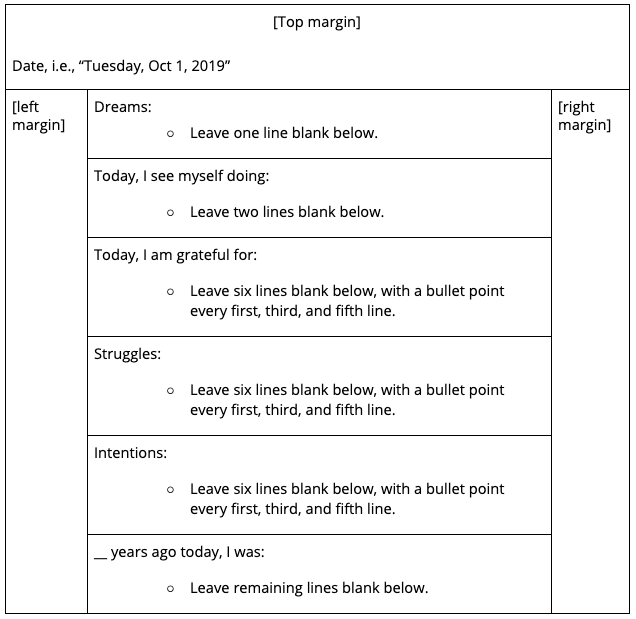Learning More about Your Subconscious through Dreams
Episode #9 of the course A daily journal practice to become a better person every day by John Robin
“Dreams are illustrations … from the book your soul is writing about you.” —Marsha Norman, American playwright and recipient of the Pulitzer Prize for Drama
Welcome to Lesson 9, our penultimate lesson!
Up to this point, we’ve focused on the main aspects of your journal. Today and tomorrow, we’re going to talk about how to go a step beyond for those who want to draw on truly advanced techniques.
By now, you’re probably familiar with the layout for each page, but for the sake of review, here it is again:

I’m repeating it for a reason. Notice what we haven’t covered yet?
That’s exactly what we’re going to dive into today.
Learning from Your Dreams: The Power of the Subconscious
Why do we sleep? More importantly, why do we dream?
Human beings and our close ancestors evolved special genes that increased brain size in a way that gave us our analytical capabilities. One of the greatest tools we created with this capability is language. Language allows us to reason and plan. With this, we’ve been able to devise ideas that create technology and science.
Language is what we’ve been using in this journal so far. You are seeing the power of language at work in your personal sphere.
Dreaming is a language, which you can learn to speak well if you practice, which is what I’m going to teach you today. I will be brief, though—I could write a whole course on this!
Ask a Question to Your Subconscious
Let’s talk first about what the top margin is for.
Thomas Edison is famous for doting on the power of asking his subconscious a question before nodding off for a nap. He would sleep in a chair with a ball bearing in his hand, arm dangled over a bucket. The moment he nodded off, the ball would drop and awaken him.
This wasn’t a strategy to shorten his naps. He was trying to pull himself out of sleep just as he started dreaming, so the answers to the problems he was meditating on might come to him from his subconscious.
You don’t have to be as radical as Edison, but you can try his strategy by using the top margin at the end of every day to ask your subconscious the most pressing question on your mind.
For example, if you’re struggling with overeating and want to know why you keep falling into the same trap, you might write in the top margin: “Why do I always overeat?”
The power of this comes in the next step …
The Right Margin
You can analyze the dream you wrote down in the morning, using the free space in the right margin.
Here are guidelines to keep it practical:
• Find simple symbols. If you dream of your partner on a horse in a square pool, then three symbols in that dream are: horse, pool, and square.
• Google, “Dream meaning ___,” where ___ is the given symbol. Keeping your symbols general means you will likely find a universally agreed-upon interpretation.
• Try to put the symbols together with the question you asked your subconscious at bedtime.
Using the example above, a horse symbolizes power, strength, and sexual prowess, while a pool symbolizes emotion, and a square represents feeling confined or enclosed.
So, your partner on a horse in a square pool might mean you’re feeling that your intimate relationship is under emotional constraint.
If your question before bedtime was, “Why do I always overeat?”, your subconscious might be trying to tell you that deep down, you’re not satisfied somewhere in your relationship, and that suppressed emotion might be a deeper reason you’re overeating.
The Left Margin
If you’re wondering what the left margin is for, it’s a great place for notes. Sometimes, I use it to jot down an insight or write down a movie I saw that I enjoyed.
Homework
Start analyzing your dreams using the guidelines we learned today. At the end of every day, reflect on the most pressing question you might ask your inner, wise self, then go to sleep, viewing your dreams as a window to possible answers.
Tomorrow, we’ll move beyond the page and talk about higher extensions of this journal through weekly and higher forms of reflection.
Recommended book
The Dream Interpretation Dictionary: Symbols, Signs, and Meanings by J.M. DeBord
Recommended Highbrow course follow-up
“Sleep Hacks: Using Science to Improve Your Sleep” by John Robin
Share with friends

